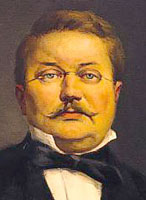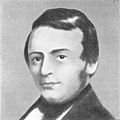Ferdinand Ritter von Hebra facts for kids
Quick facts for kids
Ferdinand Ritter von Hebra
|
|
|---|---|

Ferdinand Ritter von Hebra
|
|
| Born | 7 September 1816 |
| Died | 5 August 1880 (aged 63) |
| Nationality | Austrian, (Austro-Hungarian) |
| Known for | Vienna School of Dermatology |
| Scientific career | |
| Fields | Dermatology |
| Influences | Carl Freiherr von Rokitansky |
Ferdinand von Hebra was an important Austrian doctor who lived from 1816 to 1880. He is famous for being a founder of modern dermatology, which is the study of skin diseases. He helped create the New Vienna School of Dermatology, a group of doctors who changed how we understand and treat skin problems.
Contents
Early Life and Education
Ferdinand von Hebra was born in 1816 in Brno, which was then part of the Austrian Empire. His father was a military officer. Hebra first studied in Graz. Later, he went to the University of Vienna and became a doctor in 1841. A big influence on him was Carl Freiherr von Rokitansky. Rokitansky helped start modern pathological anatomy, which is the study of diseases by looking at body tissues.
Contributions to Dermatology
When he was still young, Hebra wrote a very important book. It was called Atlas of Skin Diseases. This book had amazing pictures drawn by famous medical artists, Anton Elfinger and Carl Heitzmann. It helped doctors understand skin conditions much better.
In 1844, Hebra wrote about scabies, a very itchy skin condition. His work made it clear that tiny mites cause scabies. Before this, people thought scabies was just a general term for many itchy skin problems. Hebra showed it was a specific disease caused by these mites.
In the mid-1800s, Hebra also started using chemical peels to improve skin. He used special liquids like phenol and nitric acid. He used them carefully to treat things like freckles and uneven skin. His work greatly influenced other doctors, like Carl Mayrhofer.
Working with Ignaz Semmelweis
Hebra was a friend and supporter of another famous doctor, Ignaz Semmelweis. Semmelweis discovered that doctors could prevent a dangerous illness called puerperal fever by washing their hands with a special solution. Hebra was the editor of a leading Austrian medical journal. He announced Semmelweis's important discovery in his journal in 1847 and 1848.
Hebra believed Semmelweis's work was as important as Edward Jenner's discovery of the smallpox vaccine. Hebra was one of the few friends who stayed in touch with Semmelweis after Semmelweis left Vienna.
Images for kids
See also





